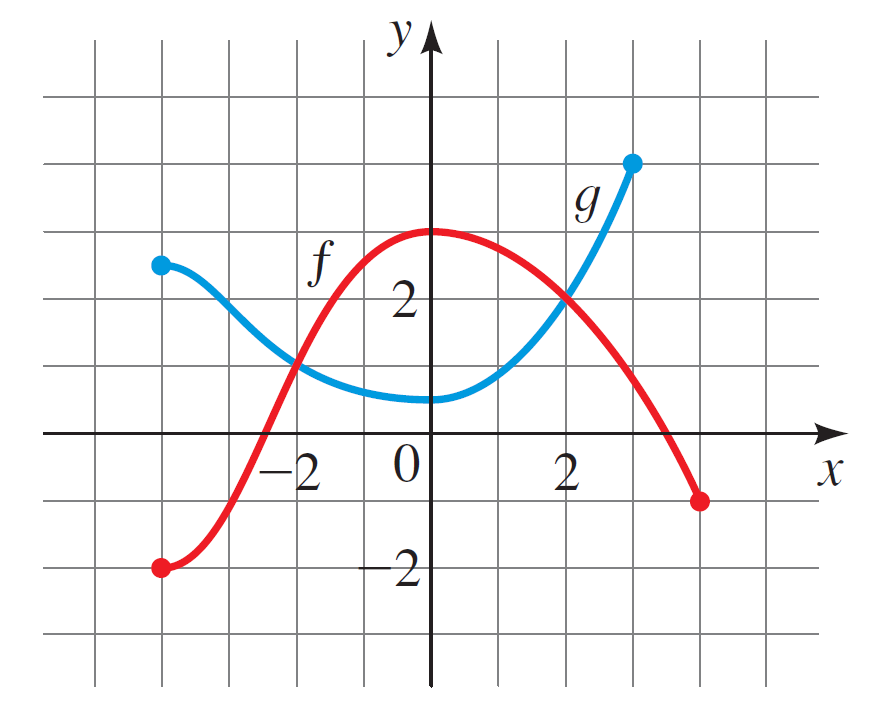Homework 6
Directions:
- Show each step of your work and fully simplify each expression.
- Turn in your answers in class on a physical piece of paper.
- Staple multiple sheets together.
- Feel free to use Desmos for graphing.
Answer the following:
- Given the two functions $f$ and $g$
- What is $f(0)$?
- What is $g(3)$?
- Solve the equation $f(x) = g(x)$.
- On what intervals is $f(x)$ increasing and decreasing?
- On what intervals is $g(x)$ increasing and decreasing?
- What is the local maxima of $f(x)$?
- Solve the following equations with 1.4 methods or using the graph. You can use Desmos (but graph both graphs on the homework you will submit).
- $x - 2 = 4 - x$
- $x^3 + 3x^2 = -x^2 + 3x + 7$
- $16x^3 + 16x^2 = x + 1$
- $1 + \sqrt{x} = \sqrt{x^2 + 1}$
- Find the increasing/decreasing intervals and all local maxima/minima and the location at which they occur:
- What is the average rate of change of $f(x)$ on $(a, b)$ defined as?
- If a function has negative average rate of change on $(a, b)$, must it be decreasing on $(a, b)$?
- Find the net change and average rate of change for the following functions between the given values. Fully simplify (expand/combine like terms/etc.) whenever necessary.
- $f(x) = 3x - 2; \qquad (2, 3)$
- $f(x) = x^3 - 4x^2; \qquad (0, 10)$
- $f(x) = 3x - 2; \qquad (2, 3)$
- $f(x) = 1 - 3x^2; \qquad (2, 2 + h)$
- $f(x) = \dfrac{1}{x}; \qquad (x, x + h)$
- Given the function $g(x) = -x - 2$, describe the blueprint of transformations to transform $f(x) = x$ into $g(x)$. Graph each function in the blueprint.
- If I have a base function $f(x)$, explain in English what the following transformations will do to $f(x)$:
- $f(x + 2)$
- $f(-x)$
- $-f(x) - 3$
- $-f(-x + 3)$
- $-f(-x)$
- Graph the following using transformations. Write out the blueprint of transformations to arrive at $f(x)$.
- $f(x) = \sqrt{x + 4} - 3$
- $f(x) = -(x-1)^2$
- $f(x) = -\sqrt{-x + 3} + 4$
- Suppose \[f(x) = \sqrt{x} \qquad g(x) = \sqrt{-x - 2} \qquad h(x) = \sqrt{- x + 2} \qquad i(x) = \sqrt{-(x + 2)}\]
- Is $g(x)$ horizontally shifted two units to the right from $f(x)$? Why or why not?
- Is $h(x)$ horizontally shifted two units to the right from $f(x)$? Why or why not?
- Is $i(x)$ horizontally shifted two units to the right from $f(x)$? Why or why not?
- Suppose \[f(x) = x^3 \qquad g(x) = \left(-x - 4\right)^3 \qquad h(x) = \left(-x + 4\right)^3 \qquad i(x) = (-(x+4))^3\]
- Is $g(x)$ horizontally shifted four units to the left from $f(x)$? Why or why not?
- Is $h(x)$ horizontally shifted four units to the left from $f(x)$? Why or why not?
- Is $i(x)$ horizontally shifted four units to the left from $f(x)$? Why or why not?
- Suppose $f(x) = \sqrt{x}$. We want to vertically shift $f(x)$ upwards 3 units, left four units, reflect around the $x$-axis, and reflect around the $y$-axis to make a new function $g(x)$. What is the formula of $g(x)$?


